
Best False Ceiling Materials: Top Trending for Modern Designs in 2024
Introduction
False ceilings, also known as drop ceilings or suspended ceilings, are a popular design element in modern interiors. They are installed below the main ceiling to create a sleek and clean look while offering practical benefits. These ceilings can conceal wiring, pipes, and ductwork, contributing to a clutter-free space. Additionally, false ceilings enhance the room’s acoustics by reducing noise levels and can improve insulation, helping to maintain a comfortable temperature. The cost of a false ceiling depends on several factors, including the material chosen, design complexity, and installation requirements. With a variety of materials, designs, and lighting options available, false ceilings add a touch of elegance and functionality to any room, making them an ideal choice for both residential and commercial spaces.
At Kolte-Patil, we believe in empowering homeowners to express their creativity and personalise their living spaces. Our homes are thoughtfully designed to inspire you to explore and implement innovative false ceiling ideas that align with your unique style. This approach ensures that your living environment is a true reflection of your individuality, combining comfort, elegance, and personal expression. If you’re curious about new developments that could enhance your living experience, such as Kolte Patil’s expansion in Mumbai, reach out to Kolte Patil Developers Ltd. and discover more ways to make your house a home.

Different Types of False Ceiling Materials
1) POP Ceilings
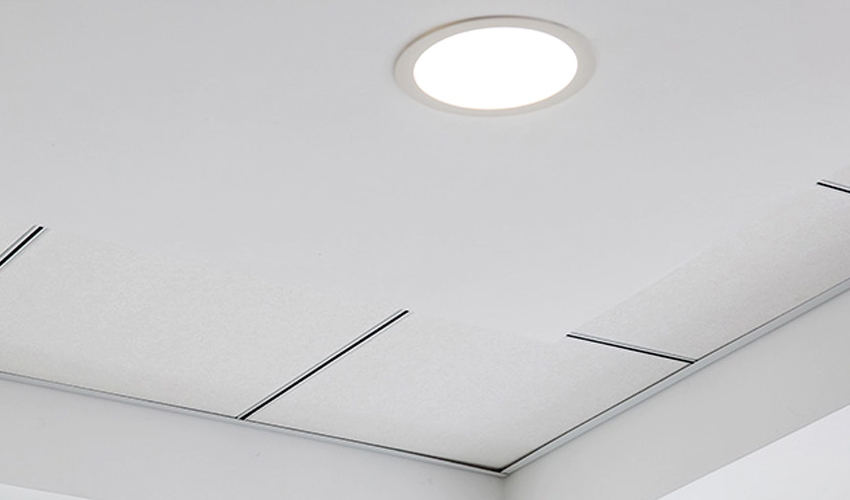
POP (Plaster of Paris) is a powder that solidifies when mixed with water to form a desired shape. These are applied to chicken meshes, fibre boards or wooden boards to form a particular design and shape. Once dried, they are fixed to ceilings. POP False ceilings are highly durable and long-lasting. They also have room insulation properties that help maintain the temperature of the room against heat or cold.
When designed, carved, and paired with appropriate lighting, POP ceilings don’t disappoint.
Advantages of POP Ceilings:
- Design Flexibility: POP (Plaster of Paris) is renowned for its versatility, allowing for custom and intricate false ceiling designs that cater to diverse aesthetic preferences.
- Smooth Finish: It offers a seamless and paintable surface that integrates flawlessly with any interior theme.
Disadvantages of POP Ceilings:
- Installation Time: POP requires a considerable setting time, which could extend project timelines.
- Weight: The material’s heaviness may necessitate additional structural support, complicating the installation process.
2) Gypsum Ceilings

Gypsum ceilings are factory-made boards that are very popular amongst home designers. Installing gypsum boards is a seamless and quicker process than POP because it doesn’t involve a messy procedure and is in a ready-to-install shape. Gypsum boards are more expensive than POP false ceilings because they’re cut to different sizes and are made at the factory.
Advantages of Gypsum Ceilings:
- Efficient Installation: Gypsum boards are pre-fabricated, enabling quicker and neater installations compared to traditional ceiling materials.
- Acoustic Benefits: These ceilings provide significant sound insulation, ideal for residential apartments.
Disadvantages of Gypsum Ceilings:
- Moisture Vulnerability: Gypsum is prone to damage in moist environments, making it less suitable for areas like kitchens and bathrooms without proper ventilation.
3) Wooden Ceiling

Wooden ceilings were among the earliest materials used in false ceiling designs, offering a timeless and natural aesthetic that complements various interior styles. Their warmth and versatility laid the foundation for the evolution of modern ceiling materials.
Wood brings in elegance and warmth, seamlessly to any room. The best part about this type of ceiling is that it can be used as a plank, beam or in any shape with other complementary materials. A hybrid ceiling can be made with wood and other materials like gypsum, glass, metal etc.
Lastly, finishes in veneer, varnish, melamine, and lacquers make wood appear even more glossy and sophisticated.
Advantages of Wooden Ceiling:
- Warmth and Elegance: Wood adds a natural elegance and warmth to any space, enhancing the room’s comfort and aesthetic.
- Longevity: Treated wood offers durability and resistance to wear, maintaining its quality over time.
Disadvantages of Wooden Ceiling:
- Costly and Maintenance-Intensive: Wood can be expensive to install and maintain, requiring regular treatment to avoid damage from moisture and pests.
4) PVC False Ceiling
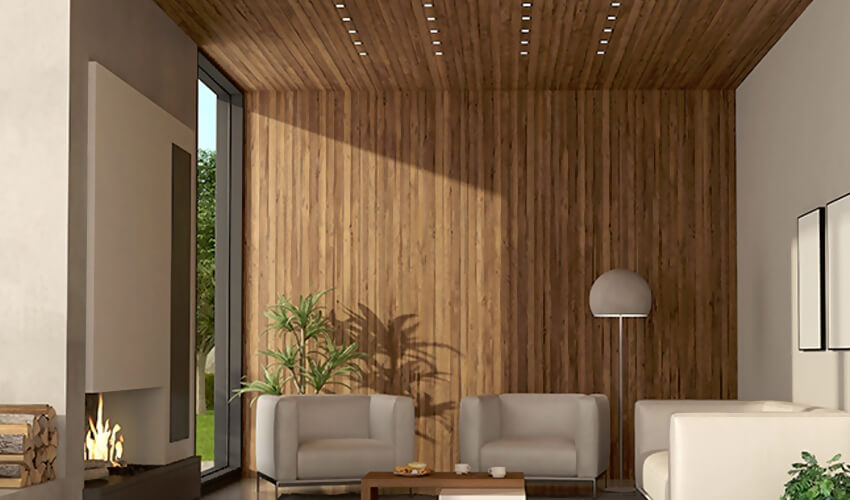
One of PVC’s biggest advantages is that it’s water-resistant. Poly Vinyl Chloride (PVC) false ceilings are budget-friendly, creative, and versatile for home designs. It is a durable and lightweight, factory-manufactured material. It can also be cut, shaped, and sized as per your requirements. This type of false ceiling material can be used in kitchens, bathrooms, basements, and garages.
Advantages of PVC False Ceiling:
- Moisture Resistance: PVC excels in humid conditions, making it ideal for bathrooms and kitchens.
- It is a water-resistant, termite-proof material.
- It is cost-effective compared to other types of false ceiling materials.
- Ease of Maintenance: This material is easy to clean and maintain, ensuring longevity with minimal effort.
Disadvantages of PVC False Ceiling:
- Environmental and Health Concerns: The chemical composition of PVC may raise health and environmental concerns due to the substances used in its production.
- It is made of plastic and falls prey to heat damage. It is not fire-resistant and is not suitable for hot areas.
5) Metal Ceiling
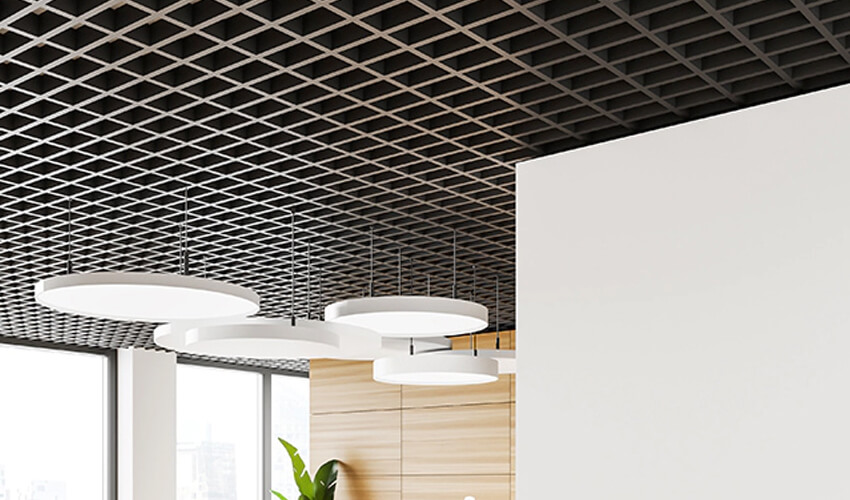
Metal false ceilings are readily available and manufactured in various shapes and sizes. Various metals like iron, steel and aluminium are used to construct it. This type of false ceiling material is perfect for commercial spaces and lofts. Since these are manufactured and pre-made, they are comparatively easier to install.
Metal false ceilings are the most durable option among the various types of false ceilings, emphasizing their construction from strong materials like aluminum and steel, which ensure longevity and fire-resistance.
Advantages of Metal Ceiling:
- Robustness: Metal ceilings are highly durable, offering resistance to physical damage and longevity.
- Fire Safety: They are inherently fire-resistant, enhancing the safety profile of your home.
Disadvantages of Metal Ceiling:
- Sound Reflection: Metal can reflect sound, potentially increasing noise levels unless properly managed with acoustic treatments.
- Maintenance cost for metals is high because they fall prey to rust.
- They must paint with a protective coating to avoid corrosion.
6) Glass Ceiling
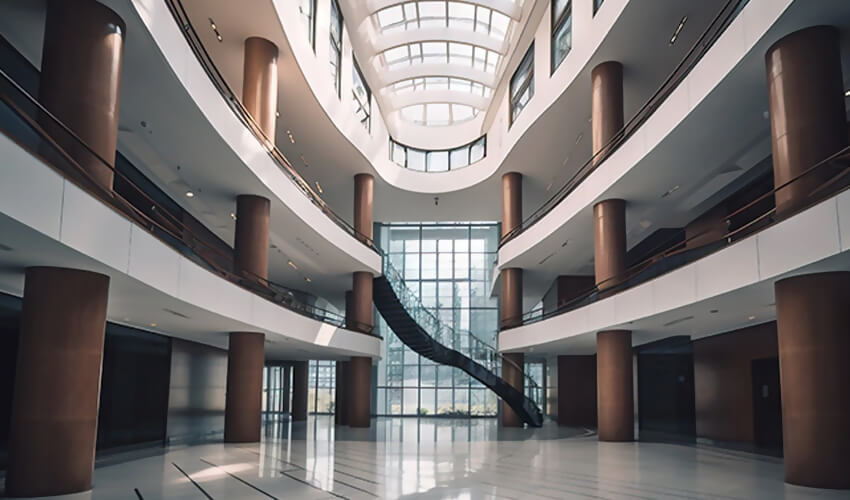
Glass False Ceiling is less common but when used in interior design it creates stunning visual effects and adds an element of luxury and sophistication. You may see that glass is commonly seen in commercial space and the reason is that glass is fire-resistant. In residential spaces, you may see stained glass in prayer rooms as a decorative false ceiling design idea. False ceilings can also be used as a statement wall in room designs, enhancing the overall aesthetics of interior spaces.
Advantages of Glass Ceiling:
- Modern Appeal: Glass provides a sleek and modern look, creating an illusion of more space and enhancing natural light distribution.
- Aesthetic Versatility: It pairs well with various decors, adding a touch of sophistication.
Disadvantages of Glass Ceiling:
- Fragility and High Cost: Glass is delicate and expensive to install and maintain, requiring careful handling.
7) Acoustic False Ceiling –
Acoustic ceilings are made up of tiles that are divided into metal grids and are best used in areas with a lot of hard surfaces where sound bounces quickly from walls to ceilings to floors. They come in a variety of reflectivity levels, as well as fire and humidity resistance.

They’re becoming increasingly popular in a variety of settings. Acoustic tile ceilings can be seen in homes, companies, and schools. They are a cost-effective option for decreasing the height of a modern space, but they also have other advantages. Ambient noise is also reduced by acoustic ceilings.
So, how do they function? Individual panels of sound-absorbing material are dropped into the portions of metal strips suspended from the room’s real ceiling. They also have the potential to conceal heating and cooling ducts, as well as unsightly cables and pipes. Acoustic ceilings are a popular choice for basement remodels because of this.
Acoustic Ceilings Have a Lot of Advantages
- Acoustic ceiling tiles may help decrease noise in a building considerably.
- Assist in increasing energy efficiency
- Assist in making your home more comfortable all year.
- Improve the look of your interior spaces without having to spend a lot of money on renovations.
- Unattractive cables, pipes, and ducting can be hidden.
What are the disadvantages of an acoustic board ceiling?
The drawbacks of adding an acoustical ceiling is that they are often expensive and may have questionable esthetics. They also consume space which makes the ceiling lower.
Other Different Types of False Ceiling Materials: Fibre, Fabric and Synthetic
- Fibre Ceilings: Appreciated for their sound absorption and moisture resistance. It is a strong and durable type of false ceiling material made with a mixture of synthetic and natural materials like wood, asphalt, tar, vegetable fibre, stone etc.
They are often used in commercial spaces, fiber or mineral fiber tiles are cost-effective and provide good sound insulation. They are typically used in suspended ceiling systems and are easy to replace if damaged.
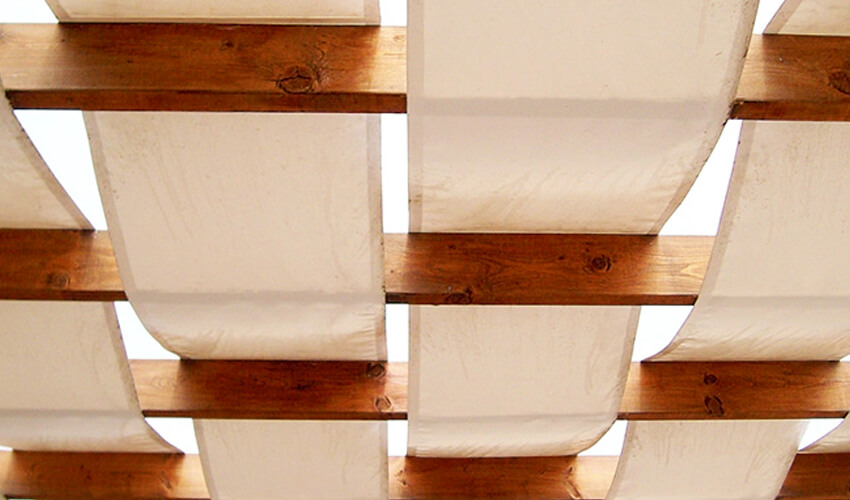
- Fabric and Synthetic Ceilings: Offer lightweight alternatives with customizable textures and colors for unique interior themes.
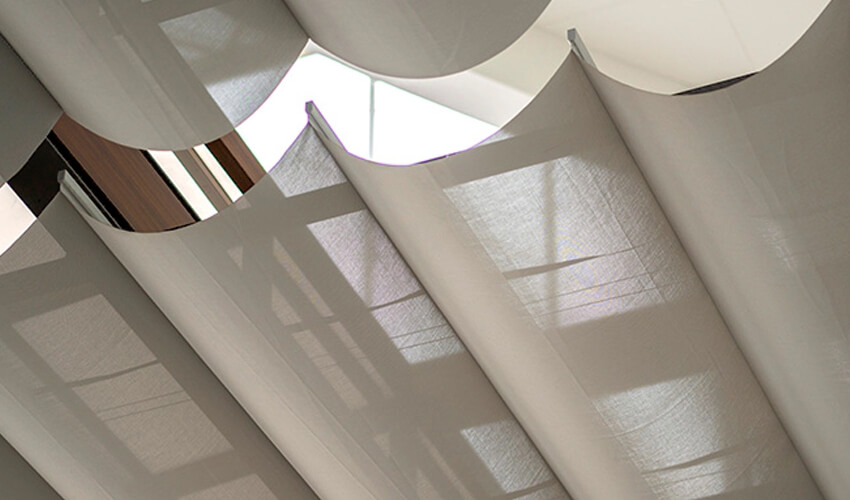
False Ceiling Design and Trends
False ceiling designs have become an essential aspect of interior design, offering a wide range of options to enhance the aesthetic appeal of a room. With various false ceiling materials like gypsum, metal, and glass, homeowners can create unique and intricate patterns that add to the overall ambiance of the space. False ceiling tiles and ceiling panels are popular choices for achieving a modern and sleek look, while also providing excellent sound insulation and thermal insulation.
The use of natural and synthetic materials in false ceiling design has gained popularity, offering a variety of options with fire-resistant and moisture-resistant properties. This allows homeowners to choose materials that not only look good but also meet their practical needs. False ceiling designs can be customized to suit individual preferences, ranging from simple and minimalist to complex and elaborate, making it an excellent way to add a personal touch to any room.
Installation and Maintenance
The installation of a false ceiling requires careful planning and execution to ensure a smooth finish and minimal maintenance. Choosing the right false ceiling material and design is crucial to meet the specific needs of the room, considering factors such as lighting, sound insulation, and thermal insulation. Regular maintenance is essential to extend the lifespan of a false ceiling, including cleaning and inspecting the ceiling for any cracks or damage.
Using protective coatings and sealants can help prevent damage and ensure the longevity of the false ceiling. Hiring a professional for false ceiling installation and maintenance can ensure a high-quality finish and minimize the risk of errors or damage. This approach not only enhances the aesthetic appeal of the room but also ensures the ceiling remains in excellent condition for years to come.
Sustainable False Ceiling Options
Sustainable false ceiling options are becoming increasingly popular, focusing on using eco-friendly materials and minimizing waste. Materials such as recycled gypsum, sustainable wood, and low-VOC paints are being used to create false ceilings that are not only aesthetically pleasing but also environmentally friendly. The use of natural materials like bamboo and cork can add a unique touch to a room while providing excellent thermal insulation and sound insulation.
False ceiling designs that incorporate green technology, such as solar panels and wind turbines, can help reduce energy consumption and minimize the carbon footprint of a building. Sustainable false ceiling options contribute to creating a healthier and more comfortable indoor environment while reducing the environmental impact of the building.
Innovative False Ceiling Technologies
Innovative false ceiling technologies are constantly evolving, with new materials and designs being developed to meet the changing needs of homeowners and commercial spaces. Advanced materials like fiber-reinforced polymers and nanomaterials offer excellent strength, durability, and thermal insulation, making them ideal for false ceiling applications. Smart false ceiling technologies, such as integrated lighting and temperature control systems, help create a more comfortable and energy-efficient indoor environment.
The use of 3D printing and computer-aided design (CAD) software allows for the creation of complex and customized false ceiling designs, making it possible to achieve unique and intricate patterns. These innovative technologies enhance the aesthetic appeal and functionality of a room, providing excellent durability and minimal maintenance, making them an excellent investment for homeowners and commercial spaces.
We hope you understand the basic types of false ceiling materials and are ready to commit to one.
- What is the most popular material for modern false ceilings?
- Gypsum, PVC, and POP are popular due to their adaptability and ease of installation.
- What should I consider when choosing a material for my false ceiling?
- Evaluate the room’s environmental conditions, desired aesthetics, maintenance needs, and budget.
- Can I combine different materials for a unique ceiling design?
- Absolutely, mixing materials like wood and metal can enhance both functionality and visual appeal.
- Are gypsum boards suitable for every room?
- They are best used in dry environments due to their sensitivity to moisture.
- Is metal a good choice for humid areas?
- Yes, metal’s moisture resistance makes it suitable for such conditions.
- What are the benefits of PVC false ceilings?
- PVC is cost-effective, moisture-resistant, and available in diverse designs.
- Are PVC ceilings durable?
- Known for their durability, PVC ceilings are a practical choice for longevity.
Conclusion
In conclusion, false ceilings provide a versatile solution for enhancing the beauty and functionality of any space. Painting is essential for both aesthetic enhancement and protecting the materials used in false ceilings. At Kolte-Patil Developers, we encourage homeowners to explore various materials—whether it’s gypsum, Plaster of Paris, or wood—to create a ceiling design that perfectly complements their style. With our commitment to quality and innovation, Kolte-Patil ensures that every home offers the potential for personalized, comfortable, and visually stunning living spaces.




